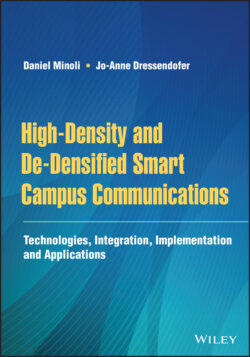Читать книгу High-Density and De-Densified Smart Campus Communications - Daniel Minoli - Страница 42
2.5.4 Space–Time Block Coding
ОглавлениеIn addition to the standard WLAN mechanisms at the MAC and PHY layers, IEEE 802.11ac incorporates STBC. Space–time Codes (STCs) involve the transmission of multiple redundant copies of the information to deal with fading and thermal noise with the expectation that some copies may arrive at the receiver in a better condition than other copies; this is known as diversity reception. In the particular case of STBC, the data stream to be transmitted is encoded in blocks, which are distributed among spaced antennas and across time [23–26]. While one must have multiple transmit antennas, it is not always necessary to have multiple receive antennas, although having multiple receive antennas improves performance.
STBC improves data transfer reliability in wireless systems by transmitting a data stream and variations of the data stream across multiple antennas. STBC is a method to transmit multiple copies of a data stream across a number of antennas and to utilize the various received versions of the data to endeavor to improve the quality and assurance of the information transfer. An STBC receiver combines all the copies of the received signal to extract as much usable information from each copy as possible. In general, scattering, absorption, reflection, multipath, refraction, and receive‐point amplifier thermal noise typically result in (some) corruption of the signal, such that some of the received copies of the information may be more faithful to the original signal than other copies. The redundancy achieved by STBC implies that there is an opportunity to use one or more of the received copies to correctly decode the received signal. An STBC is usually represented by a matrix where each row represents a time slot, and each column represents an antenna's transmissions over time.
The environment of the WLAN often distorts both the transmitted data stream and the transmitted variations of the data stream. Typically, the distortion of the transmitted data stream is different from the distortions of the transmitted variations of the data stream. A receiver receives the distorted data stream and the distorted variations of the data stream. STBC combines the distorted data stream and the distorted variations of the data stream to extract as much information from each of them as possible [2].
FIGURE 2.10 Space–time block coding [2].
In IEEE 802.11ac, STBC is used to expand the spatial streams into twice as many space–time streams; that is, 1, 2, 3, and 4 spatial streams may be expanded into 2, 4, 6, and 8 space–time streams, respectively. Alamouti's scheme is used to provide full transmit diversity gain with low complexity for a system with two antennas [20]. Each spatial stream is expanded separately using Alamouti's code as follows: for first and second symbols x1 and x2 (in a time domain), a first spatial stream transmits the symbols x1 and x2 in their original order, and a second spatial stream transmits symbols and having values corresponding to a negative complex conjugate of x2 and a complex conjugate of x1, respectively. Thus, as shown in Figure 2.10, the symbols x1 and x2 are transmitted using first and second transmitter outputs y1 and y2 at first and second times, respectively, as may be expressed by Eq. 2.1:
(2.1)
wherein for each transmitter output at each time, a top element is a symbol transmitted using a first antenna, and a bottom element is a symbol transmitted using a second antenna. Notably, the first symbol x1 is transmitted at a different time than the complex conjugate of the first symbol , and the second symbol x2 is transmitted at a different time than the negative complex conjugate of the second symbol −x2 [2].
First and second received symbols r1 and r2 at a receiver having two antennas may be expressed by Eq. 2.2:
(2.2)
where hab is a path gain for a path including an ath transmitting antenna and a bth receiving antenna, and n1 and n2 represent first and second additive white noise, respectively. The receiver can recover the transmitted symbols x1 and x2 using linear processing [2].
TABLE 2.6 802.11 Cheat Sheet
| Topic | Description |
|---|---|
| Observation | Band, Channel, and Stream have their special definitions. |
| Band | There are two general public shared bands 2.4 and 5 GHz for Wi‐Fi operation. |
| Channel | Channel is the divided small portions of frequency within each band. For example, there are 11 channels in 2.4 GHz as originally used in 802.11b which utilize 20 MHz per channel, with 15 MHz overlapping to cross over 100 MHz. |
| Stream | Stream is used since 802.11n (the first implementation of MIMO and known as Wi‐Fi 4). One stream in a single 2.4 GHz band and 40 MHz channel (with 400 ns GI) can deliver a maximum of 150 Mbps. A four‐stream Wi‐Fi 802.11n AP can deliver up to 4 × 150 Mbps = 600 Mbps (one needs to equip with 4 × 4 antenna in such AP). |
| Practical/commercial example | 802.11 ac (known as Wi‐Fi 5) still maintains the same 802.11n maximum of 4 streams per band. It operates in 5 GHz band; thus, the throughput increases to 433 Gbps per stream (often called “450” – it is almost 3 times data rate than 802.11n). Most commercial 802.11ac AP in the market are dual‐band. They only implement three streams in 5 GHz band (even though in the specification, it can support 4 streams), complemented by four streams in the 2.4 GHz band. Thus, such a Wi‐Fi AP could support 1900 Mbps of system throughput capacity with the following configuration: 3 × 433 (= 1300 Gbps) + 4 x 150 (= 600 Mbps). |
